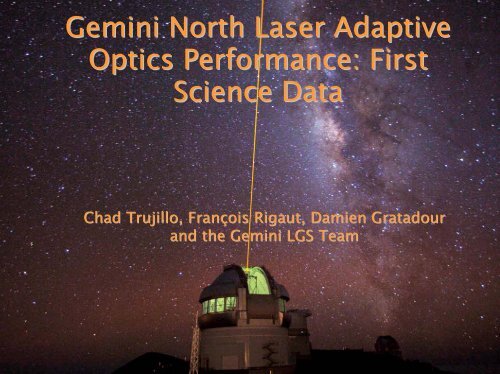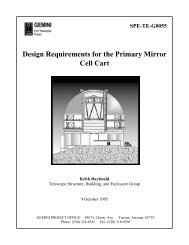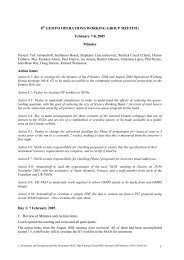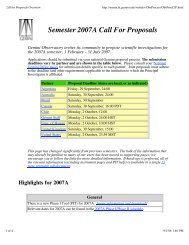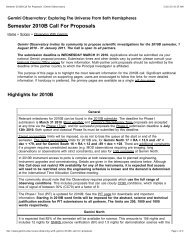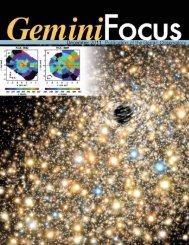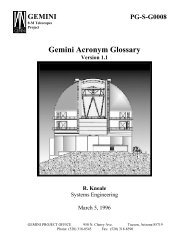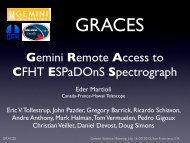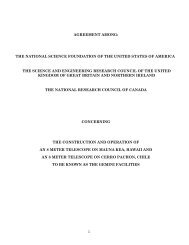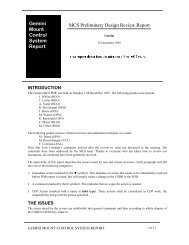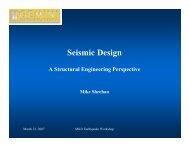Gemini North Laser Adaptive Optics Performance: First Science Data
Gemini North Laser Adaptive Optics Performance: First Science Data
Gemini North Laser Adaptive Optics Performance: First Science Data
Create successful ePaper yourself
Turn your PDF publications into a flip-book with our unique Google optimized e-Paper software.
<strong>Gemini</strong> <strong>North</strong> <strong>Laser</strong> <strong>Adaptive</strong><br />
<strong>Optics</strong> <strong>Performance</strong>: <strong>First</strong><br />
<strong>Science</strong> <strong>Data</strong><br />
Chad Trujillo, François Rigaut, Damien Gratadour<br />
and the <strong>Gemini</strong> LGS Team
<strong>Gemini</strong> <strong>Laser</strong> Guide Star (LGS) Concept:<br />
•Project V ~ 9 artificial star onto sky for adaptive optics (AO)<br />
correction using a ~10 Watt laser tuned to 589 nm (sodium<br />
layer).<br />
•High-order aberrations are corrected using the <strong>Laser</strong> Guide<br />
Star.<br />
•Only focus and tip/tilt require a Natural Guide Star.<br />
•Visible light used for AO correction, near-IR light used for<br />
science.<br />
•Allows correction similar to non-laser AO systems but over<br />
much larger sky area (40% vs. 4%), fainter depth (R ~ 18 vs. R ~<br />
15), and with less anisoplanatism.<br />
•Allows better than 0.1” angular resolution with a S/N increase<br />
of a factor of 2 to 3 over non-AO.<br />
•LGS was commissioned at <strong>Gemini</strong> in February 2007.
<strong>Gemini</strong> <strong>Laser</strong> Guide Star (LGS) Uses:<br />
Imaging (near-infrared):<br />
•Globular Clusters<br />
•Binaries: stars, brown dwarfs and solar<br />
system objects<br />
•Extended emission regions<br />
IFU Spectroscopy (near-infrared):<br />
•Embedded Star Forming Regions<br />
•Galaxy Cores
M13<br />
Altair/LGS in<br />
“mosaic”<br />
mode, 4 guide<br />
stars in 4<br />
separate<br />
pointings.<br />
1 arcmin
Orion<br />
Bullets<br />
Images of<br />
Orion taken<br />
with LGS at<br />
f/14 through<br />
the Fe II, H2<br />
(1-0) and K-<br />
band filters<br />
and then<br />
combined<br />
into one<br />
color<br />
composite<br />
image.<br />
10<br />
arcsec
Monoceros R2<br />
NIFS LGS observations of a small<br />
section of Monoceros R2 star<br />
forming region. This is an 8<br />
arcsec x 8 arcsec R~5000 K-band<br />
spectral cube composed of 8<br />
separate pointings.<br />
(K. Labrie)<br />
BrY<br />
HeI<br />
Narrow band +<br />
continuum<br />
falsecolor<br />
H2<br />
3 arcsec
Arp<br />
299<br />
False color H-band (blue) K-<br />
band (red) f/14 NIRI LGS (left)<br />
(D. Gratadour)<br />
Guiding on extended nucleus (R~14<br />
Resolution exceeds HST<br />
(H-band, right)<br />
10<br />
arcsec
<strong>Gemini</strong> <strong>Laser</strong> Guide Star (LGS) Logistics<br />
•Targets are submitted to Air Force Space Command at least 3 working days<br />
prior to observation. In practice, this means that rapid response is not<br />
available for LGS.<br />
•More personnel are needed during LGS use (mainly laser spotters and laser<br />
technicians). Scheduling is typically in one week blocks in grey/bright time<br />
each month, integrated into the <strong>Gemini</strong> queue.<br />
TT Star requirements:<br />
•R < 18.5 for point sources within 23-27 arcseconds of science target for<br />
spectroscopy and f/32 imaging (p=+/- 25, q=+27,-23). 50 arcsec<br />
separation for NIRI f/14 imaging only.<br />
•R < 16.5 for extended sources (low overhead), 16.5 < R < 18.5 (increased<br />
overhead)<br />
•TT “Star” should have a FWHM of < 1”.<br />
•Only Band 1 and Band 2 LGS programs will be observed.<br />
•Photometric conditions or nearly so are required, with reasonable seeing<br />
(CC=50%,IQ=70%).<br />
•Elevation limit is 40 degrees (hardware limit).
LGS Sky<br />
Coverage<br />
Is a strong<br />
function of<br />
galactic<br />
latitude<br />
R=18.5 with new<br />
moon and R=18<br />
with full moon.
LGS Sky Coverage<br />
Sky fraction (R=17)
LGS PSF<br />
Work on PSF<br />
optimization is<br />
ongoing.<br />
2007 Apr 30 PSF has<br />
FWHM=0.083 arcsec<br />
Strehl = 30% (K’).<br />
0.2 arcsec<br />
Native seeing was<br />
V~0.4 arcsec, star<br />
was R~12.<br />
The PSF is stable on<br />
timescales of weeks<br />
to months.<br />
0.2 arcsec
The Good News:<br />
•LGS + NIFS are an excellent combination.<br />
•LGS + NIRI spectroscopy is also a good pairing.<br />
•LGS works in all modes.
The Good News:<br />
•LGS + NIFS are an excellent combination.<br />
•LGS + NIRI spectroscopy is also a good pairing.<br />
•LGS works in all modes.<br />
Short-Term Improvements (6 months to 1 year):<br />
•Documentation (www, OT libraries, sample PSFs)<br />
•LGS + NIRI f/14 imaging PSF (core OK, wings show some asymmetry)<br />
•Acquisition time reduction (training)<br />
•LGS + NIRI f/32 imaging PSF (Strehl improvements)<br />
•Depth improvement for extended sources (slow-focus sensor)<br />
•Faint TTGS stars (Strehl improvements, depth: dichroic, iris, software)<br />
•Increase of TTGS separation from 23-27” to 30+” (HIA, minor optics work)<br />
•Integration of the Neutral Density filter into the OT
The Good News:<br />
•LGS + NIFS are an excellent combination.<br />
•LGS + NIRI spectroscopy is also a good pairing.<br />
•LGS works in all modes.<br />
Short-Term Improvements (6 months to 1 year):<br />
•Documentation (www, OT libraries, sample PSFs)<br />
•LGS + NIRI f/14 imaging PSF (core OK, wings show some asymmetry)<br />
•Acquisition time reduction (training)<br />
•LGS + NIRI f/32 imaging PSF (Strehl improvements)<br />
•Depth improvement for extended sources (slow-focus sensor)<br />
•Faint TTGS stars (Strehl improvements, depth: dichroic, iris, software)<br />
•Increase of TTGS separation from 23-27” to 30+” (HIA, minor optics work)<br />
•Integration of the Neutral Density filter into the OT<br />
Long-Term Improvements (1 year to 2 years):<br />
•Increase of TTGS separation from 30” to 60”? (HIA, major optics work)<br />
•Elevations below 40 degrees? (difficult at this point)<br />
•Vibration reduction?<br />
•Other upgrades?
Summary of <strong>Gemini</strong> <strong>North</strong> <strong>Laser</strong><br />
AO<br />
•LGS AO can feed either NIRI (imaging spectrograph) or NIFS<br />
(IFU spectrograph)<br />
•LGS AO was commissioned in Feb 2007.<br />
•System Verification (SV) observations are now finished.<br />
•It is now being integrated into the <strong>Gemini</strong> <strong>North</strong> queue<br />
operations. It is being used in the queue one week per month<br />
in grey/bright time.<br />
•Non-sidereal targets are supported.<br />
•Delivery of Strehls up to 30% with ongoing performance work.<br />
•2007A LGS queue is on schedule.<br />
•We want to hear from PIs about LGS data quality (good and<br />
bad).


